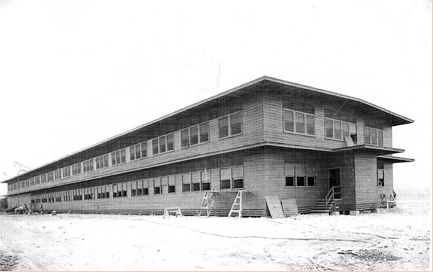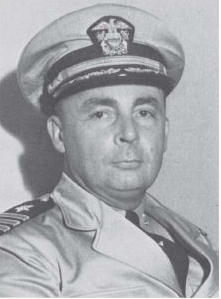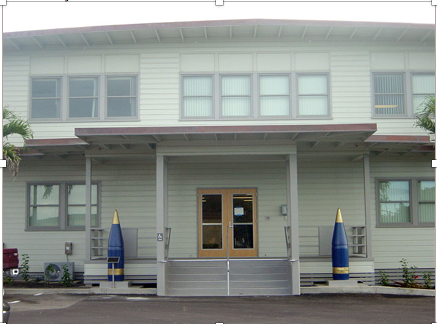Growing Like Topsy

(On the rim of Makalapa Crater at Pearl Harbor, this semi-permanent wooden structure was built in 1943 to house the Joint Intelligence Center Pacific Ocean Areas (JICPOA), where intelligence was collected, evaluated, and disseminated throughout World War II.)
“The joint intelligence center is responsible for providing and producing the intelligence required to support the joint force commander and staff, components, task forces and elements, and the national intelligence community.
– Joint Publication 2-01
I confess Mac’s account of the removal of Joe Rochefort from command of station HYPO got me riled up, and it took a while to settle down again.
Reading the account of the DC perfidy that occurred in the last few weeks in September and October of 1942 was profoundly depressing, since it was exactly the story of how things work in a bloated and bureaucratic system that exists, over time, mostly to feed itself.
Before he was ordered back to Washington for his Star Chamber, Joe was the interim Office in Charge of the new Intelligence Center-Pacific Ocean Area (IC-POA). According to Elliott Carlson, Joe hated the additional duty, and viewed it ass a distraction from the critical work being done by Station HYPO’s cryptanalysts and linguists. I think Joe had a point, at that point in the conflict, but things were going to grow like Topsy, and that is just the nature of things.
I base that on analogous experience. I reported to the Pentagon in the early stages of DESERT Shield, in the Fall of 1990. I had accepted ores to the Joint Staff JS organization before deploying to the Med the year before, in USS Forrestal (CV-59). I think I was supposed to be assistant chief, Middle East, North Africa Branch, working for the legendary Andrea Arnstett, but I had a scheme, as every good careerist must, that I would synchronize with the likely assignment of whoever the new intelligence flag officer was going to be.
In those days, it was usually a show-down for selection to Flag rank between the Fleet Intelligence Officers (N-2s) of the Atlantic and Pacific Fleets. I had worked for the PacFlt N2 before, and made a mental wager that he would be the community pick, and further, the most likely assignment would be as the Flag officer assigned to support the Joint Staff.
Ask anyone- the concept of the “Flag Chase” never works out. If you wait to negotiate for orders to work for someone you know, once you know where they are going, by the time you can extricate yourself from the assignment you are on, and actually get there, the person you wanted to work for is probably packing bags to move on.
In this case, my scheming actually worked out, though it could have been a disaster that would have buried me in the bowels of DIA.
Here is how it worked out. The new JS was indeed the PacFlt N2, and I got to the Pentagon just a month after he reported for duty to General Colin Powell. It is a good thing to be able to skip all that relationship-building nonsense, and being at war- or preparing to go to war- provides a marvelous focus on real things.
In this case, it was clear that a central clearing-house for collections and analysis was going to be needed, and a dank space on the Pentagon Mezzanine level was identified to house the National Military Joint Intelligence Center (NMJIC). It had a variety of growing pains. Privately, some called it the “Teenage Mutant NMJIIC” after the popular cartoon of the day, but grow it did. Groups of Army, Navy and Air Force people began to appear with alarming regularity, equipped with computers and telephones.
The mission was constantly changing- defense of Saudi Arabia was the beginning, and sanctions enforcement against Saddam’s government was a big deal, since that is what we were doing at the time.
That rapidly changed. Sanctions, first, then mine warfare, and Air Order of Battle, and SCUD-hunting and ground combat all followed with dazzling speed. Once the fight was on, and STORM followed SHIELD, we concentrated on Bomb Damage Assessment and mobility studies, and target nominations. The crisis de jour depended on what the forces in the field required, and of course feeding the decision-making beast in the Building.
It was the same deal it was when Joe Rochefort was sent packing in the Pacific in late 1942. Jasper Holmes reported that changing from defense to offense required new kinds of intelligence support to the operating forces.
IC-POA was cursed to attempt to meet the burgeoning requirements of the amphibious forces who were tasked to storm the beaches. That meant that the vital code-breaking had to be supplemented by skilled imagery analysts, area studies experts, map-makers, and craftsmen who could turn the maps into physical models of the objective atolls.
The only constant in the changing mission swirl was the constant change.
The initial request by the Marines was to create the IC-POA with more than 200 personnel. Only about 40 were actually available when the organization stood-up, which was a blessing, since Jasper Holmes and Mac commented that The Dungeon rhythm was upset with the arrival of all the new faces, and the sensitivity of the code-breaking made security a real concern.
The solution was to move all the IC-POA desks to the far end of The Dungeon, creating an artificial separation between HYPO and IC. With the concentration on tracking IJN naval units through the beginning of 1943, many of the original cadre of intel center officers had moved on to other priorities of the moment. By February 1943, the pipeline for linguists had begin to produce graduate. Twenty of them arrived in February, and CAPT Goggins was put in charge of both.
The organization had shops for an Objective Data Section; a Language Section; and the Combat Intelligence Unit, which was nominally a part of ICPOA but functioned as a part of HYPO. The Photographic Reconnaissance and Interpretation Section (PRISIC) was over on Ford Island, but moved to the second deck of the Kodak Hawaii Building downtown for the obvious reason- access to film.
The organizational contortions continued to lurch forward as Joe’s relief, a CAPT Bill Goggins settled into Joe’s desk. Mac recalled that the transition was aided by Joe Rochefort’s let to Jasper, urging the team to support the new guy.
HYPO itself was having growing pains. Its ranks began to swell after the Battle of Midway. The machine room was “bursting at the seams” according to Jasper, and since it required air-conditioning to make the machines happy, a new facility outside the dank Dungeon was needed.
Jasper described how the seams in The Dungeon were being stretched: “Our plotting facilities, with their expanded collections of charts and maps, required more space. The manifold file of hectographed Japanese messages, a basic source of information for the Japanese naval order of battle, grew to occupy more space than had originally been allotted to the entire unit. Even the card file of place-names had grown to more than twenty thousand cards.”
Accordingly, a building designed specially to handle the IBM machines was constructed on the rim of Makalapa Crater, immediately adjacent to the CINCPAC HQ. HYPO and IC-POA moved out of the bustling Ship Yard their new digs in April of 1943. Mac once told me at Willow the requirements for IBM punch cards were so large that the warehouse next to the new building was filled with nothing but card stock.
The building is still there, something I find remarkable. The new facility was- and is, when I stood there a couple weeks ago- isolated on a dead-end road. Then, it was surrounded by a high chain-link fence and equipped with armed Marines at the gate.
On 7 September, 1943, the tempo of offensive operations jumped into high gear. To serve the planning staffs that rotated through O’ahu, the intelligence section of Admiral Nimitz’s staff was reorganized to cope with the accelerating OPTEMPO. HYPO was administratively separated from IC-POA and transferred to the Pacific Fleet as the Fleet Radio Unit, Pacific (FRUPac).

(Captain William Goggins, the non-cryptologist selected by Washington to lead HYPO. Mac said he was a pretty good guy and didn’t have anything to do with the coup d’etat. His style was more old-school Navy than Joe Rochefort’s was. Photo USN).
Captain Goggins remained with the unit as officer-in-charge of FRUPac. IC-POA was placed directly under the assistant chief of staff for intelligence (ACOS/J-2), Joint Staff, Commander in Chief, Pacific Fleet, and Commander in Chief, Pacific Ocean Area (CinCPac-CinCPOA). To accommodate the new Joint nature of the reporting chain, it was rechristened as the Joint Intelligence Center, Pacific Ocean Area (JIC-POA).
Brigadier General Joseph J. Twitty, was appointed J-2 and officer-in-charge of JICPOA. Captain Eddie Layton remained as Fleet Intelligence Officer. The Combat Intelligence Unit of ICPOA became the Estimate Section of JICPOA, which Jasper led, supported by Mac Showers.
The war in the Pacific was hurtling forward, and the institutions had to change and grow, just like Topsy.
It is the way it works.

(The former JIC-POA Building was sinking into Makalapa Crater in the early 2000s when the Navy actually did something to preserve its history. JIC-POA and Station HYPO were here longer than they were in the famed dungeon. The blue shells on either side of the door are from the super-battleship IJN Yamato. At 18.1 inches, they were the largest ship-borne artillery ever forged).
Copyright 2015 Vic Socotra
www.vicsocotra.com
